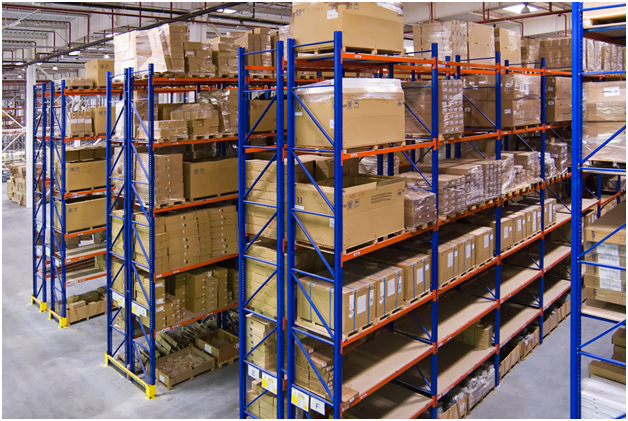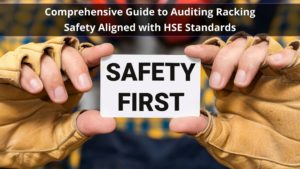
To some, the HSE guidelines and HSE racking inspection regulations might seem complex, but they are logical and easy to understand when you are armed with a bit of knowledge.
The Health and Safety Executive (HSE) is the branch of the British government that is responsible for all things to do with health and safety. As such, HSE guidelines are often seen as very important. This is not just the case for racking safety; it’s the case for workplace safety in general. So, what are HSE guidelines? Here’s a brief summary…
HSE Guidelines & HSE Guidance Documents
HSE guidelines come in the form of HSE guidance documents. These are best practice documents which offer pragmatic — rather than legal — advice on matters of occupational safety. A common misconception is that HSE guidelines and HSE guidance documents are the law. However, they are not, and this short paragraph at the start of every HSE guidance document makes this clear:
“This guidance is issued by the Health and Safety Executive. Following the guidance is not compulsory and you are free to take other action. But if you do follow the guidance you will normally be doing enough to comply with the law.”
A full version of this same caveat can be found on the HSE website.
Not following HSE guidelines is legal. However, following the guidelines is normally “enough to comply with the law”. What’s more, because the advice is from the British government, it’s advice which is as objective and trustworthy as you can get in occupational safety.
Why Aren’t HSE Guidelines Legally Binding?
HSE does also create laws and offer legal advice, but these documents are much more dense. The reason HSE guidelines aren’t legal advice is that they are intended to be used as easy-to-understand reference guides for people who already have a working knowledge of the legislation relevant to their industrial racking.
HSE guidelines are also a good introduction to occupational safety legislation within a particular industry. When HSE refers to the law or to legal guidance, this is made explicit.
HSG76: The HSE Guidance Document for Racking Safety
Every booklet of HSE guidelines is labeled HSG followed by a number. As of January 2018, there are 103 HSGs numbered from HSG17: Safety in the use of abrasive wheels to HSG279: Making paper safely.
The list of HSGs is being constantly updated as HSE seeks to improve the standards of its guidelines. As such, there are some gaps between numbers. For example, there is an HSG173 and an HSG175, but there is no HSG174.
Since 2007, the HSG most relevant to guidance with regards to HSE racking regulations has been HSG76. Its full title is HSG76 Warehouse and storage: A guide to health and safety.
To learn more about HSG76 and how you should operate your warehouse, subscribe to our free newsletter for our racking inspection checklist and our three-part guide to racking inspection maintenance.
So, what does HSG76 have to say about warehouses? What are the HSE guidelines for racking safety? Well, here’s a brief look at their general thoughts on the topic.
A Summary of HSG76 and HSE Racking Regulations
1. Has Your Contractor Attended a SEMA Course?
Lazy assumptions are enemies of safety — and HSE knows that this is definitely the case when it comes to racking safety. If there is third-party racking maintenance, or any third party work in your warehouse, the HSE guidelines for warehouse safety state that “it is not sufficient to assume that they are competent and working safely”. Rather, you should be vigilant and rigorous in this respect.
According to HSE guidelines, it is recommended that your contractor is a SEMA approved racking inspector if they are performing a third party racking inspection. Furthermore, this person should be some other kind of SEMA approved expert if they are installing, repairing, or working on your racking system in any way.
In 2015, the HSE CDM regulations made a warehouse owner’s duty to ensure that people working in their warehouse are “competent” a legal one. In other words, if you have reason to believe that the person working in your warehouse is not “competent” and you do nothing about it, you are breaking the law.
Are the techniques that your contractor is using safe? Are they SEMA approved? Is you following HSE’s advice with regards to the definition of “competent”? Your role and your legal responsibility is to make sure that you are absolutely confident that you know the answers to those questions.
2. Installing Warehouse Racking Requires Careful Planning
Plan, plan, and then plan some more is what the HSE guidelines have to say about racking system installations. At best, failure to do this will lead to an inefficient workspace. At worst, it will lead to a dangerous one. Layout of your racking system and the layout of your warehouse are two things that need to be planned together.
Business writer Stefan Topfer argues that “planning is one of the most important parts of running a business” and this advice applies to your warehouse, too. Your newest marketing campaign won’t be worth anything if your warehouse cannot store enough of your product due to uneven surfaces, badly spaced aisles, or bad maneuverability within the warehouse. Even business giants such as Anheuser-Busch have made huge mistakes because they didn’t pay attention to warehouse safety.
To make sure that your racking is installed properly and that the layout is planned effectively, HSE guidelines recommend that warehouse owners use people who have undergone the relevant SEMA training.
3. Follow HSE Guidelines with Regular Expert Racking Inspections
Once your racking has been installed, it needs to be maintained. One way of doing this is through proper use: racking should be highly visible, protected physically, never climbed on and never overloaded. However, beyond that, HSE recommends having a racking inspection by a SEMA approved racking inspector (a SARI) at least once a year.
This advice is echoed by law in the Provision and Use of Work Equipment Regulations (PUWER) 1998. In which section six highlights the importance of regular and thorough inspections for work equipment. All racking systems, including mezzanine floors, qualify as work equipment, so they are subject to this legislation.
4. Consider Racking Inspection Training for Regular Internal Racking Inspections
HSE guidelines also advise that racking inspections are done regularly by employees within the business itself. Here at Storage Equipment Experts, we provide racking inspection training delivered by SEMA approved racking inspectors, so that your business can take racking safety into its own hands as well.
Other Questions about HSE Guidelines and Racking Safety…
1. Will Brexit Affect HSE Racking Inspection Regulations?
Without the EU’s input, the people within the industry in the UK will look to organisations like HSE and SEMA even more than they already do. However, none of that means that HSE racking Inspection regulations or HSE guidelines with regards to warehouse safety will change. It just means that they could change.
The regulations as they are haven’t changed since HSE published its HSG76 guidance document in 2007. A lot of that HSE guidance document is based on EU Directive EN 15635, including the part about an expert inspection at least once every 12 months.
As such, post-Brexit, HSE could completely overhaul HSG76. Yet, this isn’t likely to happen, as there are no calls for HSE to do so. Instead, what is likely to happen is that all existing HSE legislation will remain the same.
The Great Repeal Bill will copy over everything over from EU law to British law in the UK. Of course, the contentious issues such as the border with Ireland and freedom of movement. It will need to be sorted out, but HSE racking regulation is not a contentious issue. So, it’s unlikely to change.
2. Where Can I Get The Best Racking inspections by SEMA Approved inspectors and SEMA Racking Inspection Training?
Look no further than Storage Equipment Experts! Our SEMA approved racking inspectors are one of the few people in the world to be approved by SEMA to inspect both pallet racking and cantilever racking. We deliver both racking inspections by SEMA Approved inspectors and racking inspections training courses.
Is your warehouse due a racking inspection?
Follow HSE’s sound advice and contact Storage Equipment Experts today for a quote on a racking inspection by SEMA Approved inspector.





